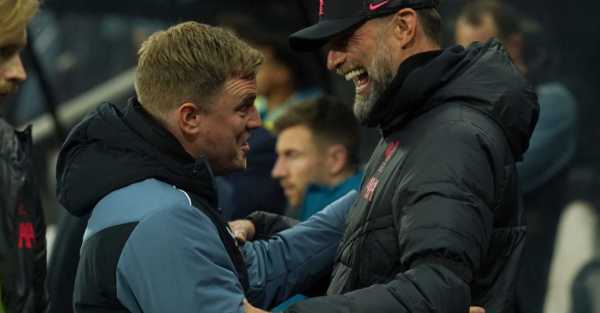
Eddie Howe will send his Newcastle side into battle with Liverpool still haunted by the memories of their encounters last season.
The Reds were the only club to complete a Premier League double over the Magpies, although they gained a measure of revenge when they went on to finish fourth – one place and four points better off than Jurgen Klopp’s men.
Advertisement
However, Howe admits it does not take much to stoke memories of the Fabio Carvalho winner in the eighth minute of stoppage time which handed Liverpool victory at Anfield last August, or the red card in a 2-0 defeat in the reverse fixture which cost goalkeeper Nick Pope his place in the Carabao Cup final.

Howe said: “I move on quickly from the game in the sense that then you have to prepare the next one, but I think the emotion of the game and the feeling and the memories of the game, they stay with you for some time.
Advertisement Advertisement
“The memories of last year’s games, they’re with me. I can visualise certain moments, but then you have to detach yourself from that and go, ‘right, how do we prepare this one?’, because whether it’s tactical or whatever the thing is that you think you can do better, it’s about then delivering that to the best of your ability.
“There’s a lot of defeats in my management career that are still there and they just need probably the emotions stoking and they’ll come back to the forefront of my brain.”
Newcastle’s resurgence, fuelled in large part by the wealth of their Saudi-backed owners, has seen them re-establish a rivalry with Liverpool which sparked a series of memorable encounters in the 1990s.
Advertisement

Klopp has on more than one occasion taken aim at the Magpies, and the two coaching teams have at times enjoyed a frosty relationship on the touchline.
However, Howe expressed surprise at the perception there is added needle between the two camps when they go head-to-head.
Asked why he believed the rivalry had become so intense in recent seasons, he replied: “I don’t know. Has it?
Advertisement
“Genuinely, I think the rivalry between Newcastle and Liverpool has always been there, historically. I don’t think it’s been ramped up particularly any more than it’s always been.
Advertisement Advertisement
“When the game’s been on historically over a number of years, it’s a game everyone will go, ‘I want to watch that, I want to see what’s going to happen’.
“There will be moments and flashpoints because they are two iconic clubs going against each other. I don’t think it’s necessarily ramped up in the last two years.”
Sourse: breakingnews.ie